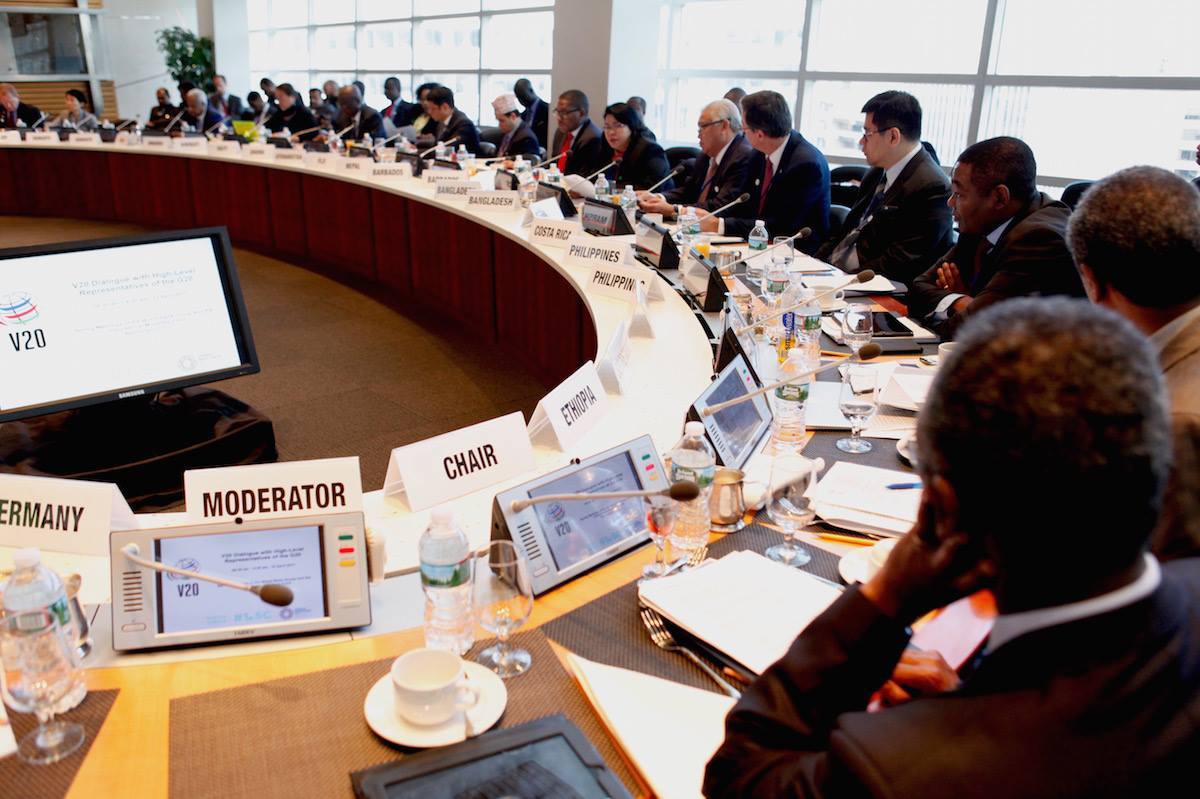
By: LakshmiPS
As droughts and floods cut crop harvests and storms tear up buildings and power lines, countries vulnerable to climate change – from Bangladesh to Kenya and Guatemala – have proposed new ways to access cheaper financing to tackle the risks.
A group of 48 developing economies, known as the V20, together with development banks this week announced plans for new financial instruments aimed at lowering the cost of capital and unlocking large capital flows for green development.
The effort could help safeguard the prosperity gains of at least 1 billion people as the planet warms, V20 finance ministers said in a statement.
“The moment calls for a robust response to protect economic growth from the risks of climate change and secure continued progress,” said V20 chair Benson Wase, finance minister of the Marshall Islands, in a statement issued during the spring meetings of the World Bank and International Monetary Fund.
The V20 economies include Barbados, Cambodia, Costa Rica, Ethiopia, Honduras, Lebanon, Morocco, Nepal, the Philippines, Rwanda, Senegal, Sudan, Tanzania, Tunisia, Tuvalu and Vietnam.
A 2018 report commissioned by UN Environment calculated that the V20 countries had coughed up an additional $62 billion in interest payments alone over the past 10 years because of their climate vulnerability.
The V20’s planned new instruments, aimed at fostering climate resilience and helping countries transition to 100 percent renewable energy, include, among other things, investment guarantees and efforts to better combine public and private money.
The countries also proposed a “Sustainable Insurance Facility” to promote insurance among smaller business as a way to help them address climate risks.
The new instruments would tap funds from a range of investors, including development banks and the private sector.
In a statement, the V20 said they faced barriers such as higher costs of capital, which limit the scope of projects, as well as “huge inefficiencies” in accessing international climate finance.
The financing difficulties listed by the V20 chimed with the conclusions of a separate report issued this week by the London-based Overseas Development Institute (ODI) on blended finance, which involves using funds provided by governments and development banks to encourage private investment in poorer nations.
The report found policy makers have overblown expectations about how much private money can be mobilised, especially for low-income countries which are receiving very little.
The ODI researchers calculated that every $1 of public money invested mobilised just $0.37 of private cash in low-income countries, and only $0.75 in all developing states – ratios much lower than those often cited by development banks.
REALITY CHECK
Lead author Samantha Attridge, a senior research fellow at ODI, said the figures showed “an urgent reality check on blended finance is needed”.
The report said international expectations that blended finance could bridge the financing gap for reaching 17 global goals – which include ending poverty and hunger by 2030, and adapting to climate change – were unrealistic.
For example, only 1 percent of all private finance mobilised by the British government from 2012 to 2015 was in the poorest countries.
In addition, flows of blended finance go predominantly to “hard” economic sectors, such as infrastructure and banking, with very little for social programmes, including health and education, the report said.
Attridge told the Thomson Reuters Foundation too much emphasis on blended finance could suck aid money from efforts to tackle poverty in the most needy places.
“There is a risk that all this money is going to be invested in this way, but we don’t actually know what the impact of that is in terms of poverty reduction,” she added.
Luigi Carafa, executive director of the Barcelona-based Climate Infrastructure Partnership (CLIP), said the report’s findings were not surprising given the constraints on private-sector investment in the poorest countries.
In many places, financial markets are still not sturdy or stable enough, the risks too high, and the size of projects seeking funding too small, he noted.
For those reasons, blended finance was unlikely to be the “holy grail” for those economies, as touted in the past few years, he said.
“This is a huge problem, and we have to find alternative ways to solve it,” he said.
The ODI report said there was a need for grant financing to strengthen local investment climates, to make them more attractive to the private sector.
In addition, donor governments should require lower rates of return on the money they provide to development banks, enabling them to take on more risk.
CLIP’s Carafa said much could be achieved by following the models used by countries such as Morocco and Argentina, which have successfully leveraged blended finance to build clean power plants.
(Reuters)
